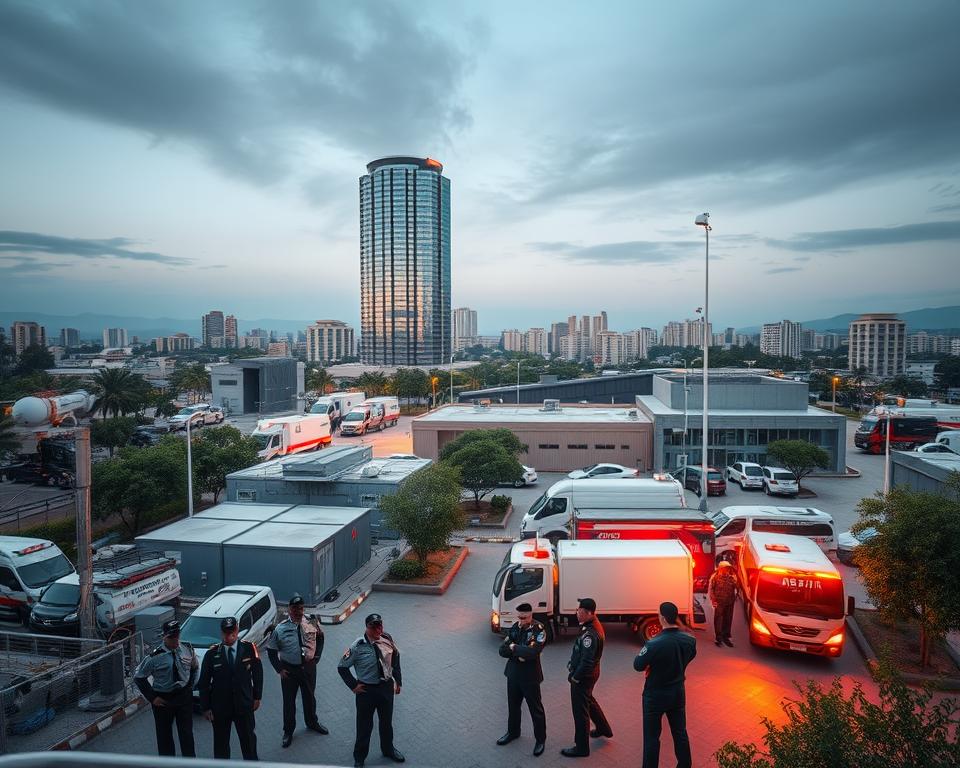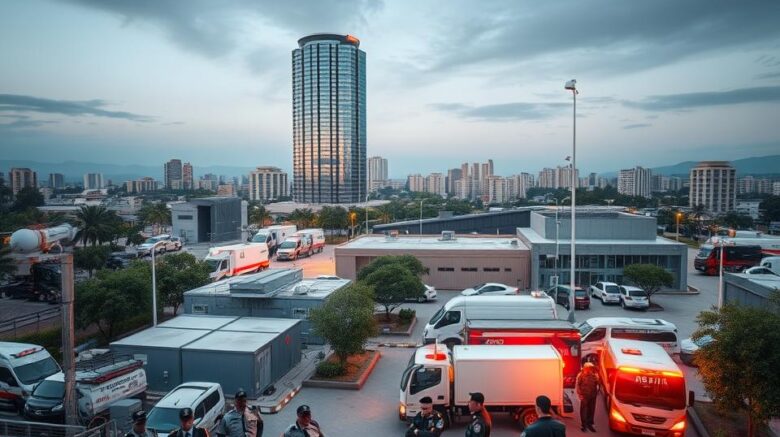Upgrading Your Safety using Mall Security Measures
Suppose safer shopping involves more than cameras and guards? As crowds grow and risks evolve, safe areas call for more than classic methods. Today’s threats require intelligent strategies combining human skill and advanced tech.
In light of increasing public safety worries, businesses now prioritize robust protection systems. Divine Protection Services champions this movement, merging strict training with advanced tools to define industry benchmarks. Their philosophy centers on proactive commercial security tactics rather than reactive measures.
Well-prepared officers play a vital role in maintaining order. They observe bustling areas, manage crisis situations, and create trust through their visible presence. This people-first philosophy makes sure shoppers and staff feel safe on each visit.
The following sections will examine how surveillance advancements and access controls form coherent security networks. Find out how strategic planning reshapes malls into safe zones while aiding business growth.
Grasping the Need for Mall Security
Establishing safe areas for patrons and staff involves more than visible patrols. Contemporary protection strategies depend on multi-layered approaches integrating technology, training, and teamwork. These systems not only respond to incidents—they preempt them.

The Role of Surveillance and Access Control
High-definition cameras and smart entry systems form the backbone of modern safety plans. Sensors placed strategically monitor busy areas like entrances and parking lots. This arrangement lets staff detect odd behavior swiftly.
Access management tools limit entry to restricted areas while letting visitors move freely through shops. Routine equipment inspections make sure cameras and scanners operate perfectly. Real-time monitoring helps teams respond before minor issues escalate.
Security, Reputation, and Customer Experience
Skilled officers do more than view screens—they aid lost visitors and defuse conflicts. Their visibility soothes patrons, encouraging extended visits and repeat trips. A single event can erode trust, making prevention essential.
Supporting ongoing staff education makes certain teams respond to medical crises or crowd surges efficiently. When protection measures align with daily operations, businesses thrive alongside safer environments.
Divine Protection Services: Your Ally in Mall Safety
When security is paramount, companies need partners who provide more than assurances. Divine Protection Services stands out by blending advanced tools with skilled personnel to address modern risks. Their tactics evolve with new challenges while keeping a hospitable atmosphere for visitors.
Our Comprehensive Security Approach
This agency integrates three pillars for utmost effectiveness:
- Smart surveillance networks covering high-traffic zones
- Access control systems that regulate entry without impeding foot traffic
- Frequent equipment upgrades ensuring consistent performance
Their crew uses live data to recognize odd patterns, from unattended bags to unpermitted entries. This preemptive method stops problems before they worsen, preserving public areas secure yet accessible.
Equipping Security Officers with Training and Support
Divine Protection Services dedicates substantial resources to skill development. Officers undergo:
- BST certification for managing aggressive situations
- First aid training for medical emergencies
- Customer service classes enhancing guest interactions
Ongoing development opportunities guarantee teams are equipped for different scenarios. “Our officers aren’t just guards—they’re safety ambassadors,” remarks a company mouthpiece. This focus on growth fosters confidence in both personnel and shoppers, creating environments where everyone thrives.
Training, Certifications, and Team Excellence in Security
Empowering security personnel starts with more than just a uniform—it demands rigorous preparation. Teams thrive when equipped with certifications and hands-on practice tailored to modern challenges. This foundation turns everyday interactions into opportunities to build trust and prevent incidents.
Core Training Programs and Certifications
Officers begin with three core certifications: BST for conflict resolution, first aid for medical crises, and non-violent intervention tactics. These abilities aid in defusing tense scenarios while putting visitor safety first. Regular workshops refresh these abilities, ensuring teams adapt to new threats.
Simulation drills imitate real-world incidents such as crowd surges or missing children. Online modules cover evolving trends, from digital scanning tools to accessibility guidelines. “Training never stops—it evolves,” explains a Divine Protection Services instructor. This method keeps teams prepared for both standard duties and sudden alarms.
Establishing a People-First Culture in Security
Continuous learning fosters empathy and problem-solving skills critical for public spaces. Guards schooled in customer service guide shoppers with directions or store suggestions, combining safety with hospitality. This combined focus builds inviting environments where people feel appreciated.
Divine Protection Services strengthens this culture via mentorship initiatives and equipment proficiency sessions. Self-assured, well-backed teams mitigate risks while bolstering community ties. The payoff? Safer retail spaces where employees and visitors alike can focus on core activities.
Mall Security: Guidelines for a Secure Shopping Environment
How do busy shopping centers balance safety with seamless visitor experiences? The key is pairing attentive technology with welcoming personnel. Today’s tactics emphasize preventing problems while upholding inviting environments.
Boosting Visibility via Technology
High-resolution cameras now cover key zones like parking garages and food courts. These systems use motion detection to flag unusual activity, such as lingering packages or erratic movements. Central dashboards let teams observe multiple areas at once.
Periodic upkeep tests confirm sensors and alarms work without issues. “Our weekly system evaluations avert 90% of possible malfunctions,” says a retail safety manager. Merging live footage with AI scrutiny helps find patterns human eyes may miss.
Blending Safety With Hospitality
Trained officers often function as information guides. They support customers with store directions, lost items, and parking inquiries. This double role nurtures trust while guaranteeing security.
Access management tools like smart turnstiles filter entry to staff-only zones without slowing foot traffic. Color-coded IDs enable instant identification of authorized personnel. During rush hours, temporary checkpoints regulate crowd flow near top stores.
Monthly collaborative meetings between teams make sure everyone knows emergency protocols. Simple upgrades—like brighter lighting near restrooms—can deter incidents while improving visitor comfort. When technology and teamwork align, public areas become both safer and more enjoyable.
Addressing Emergencies and Crowds in Shopping Malls
When time is critical, how do busy spaces change chaos into order? Effective emergency plans blend clear protocols with practiced teamwork. Preparation transforms possible disasters into controllable scenarios where everyone understands their role.
Effective Emergency Management Techniques
Preset action plans are essential in emergencies. Crews use color-coded signals to mark different threat levels—red for fires, yellow for medical issues. This setup helps staff respond quickly without confusion.
Primary strategies encompass:
- Assigned evacuation pathways marked with glow-in-the-dark signs
- Real-time updates through encrypted earpieces
- Automatic lockdown features for restricted zones
Security officers schooled in crowd psychology guide visitors with tranquil verbal hints and visual signals. “We hold疏散 drills monthly to preserve instinctive reactions,” shares a retail safety coordinator. Video feeds help spot bottlenecks, enabling teams to reroute traffic before panic spreads.
Local fire services get real-time updates via integrated systems during incidents. Combined training exercises ensure seamless teamwork. After-action reviews pinpoint areas for improvement, like faster first aid deployment.
A Midwest mall cut evacuation times by 40% after improving their speaker system. Continuous updates to response plans ensure teams respond to new challenges while preserving visitor confidence.
Technological Progress and Future Directions in Mall Security
Imagine entering a place where safety systems foresee threats before they occur. Cutting-edge innovations are reshaping how public areas protect visitors while enhancing convenience. From AI-powered analytics to biometric scanners, future solutions merge accuracy with smooth operation.
Smart Systems for Proactive Protection
Machine learning now processes camera feeds to spot anomalous behavior, like abandoned bags or erratic movements. These tools signal potential dangers faster than manual monitoring. Predictive models scrutinize historical data to forecast peak traffic moments, guiding teams in allocating resources effectively.
Advanced access systems use facial recognition to grant entry to restricted zones. “Biometric technology cuts unauthorized entry by 78%,” notes a retail safety expert. Live dashboards show crowd density stats, letting officers reroute foot traffic before bottlenecks arise.
Training modules now integrate virtual reality simulations. Security staff practice tackling scenarios from medical emergencies to active threats. This practical method fosters muscle memory for high-stress scenarios.
Projected trends include drone patrols for parking lots and IoT sensors identifying environmental hazards. As technology advances, shoppers experience smoother visits while feeling secure. Enterprises deploying these tools stay forward in building spaces where safety and satisfaction thrive jointly.
Closing Thoughts: Elevating Mall Safety with Confidence
Establishing safer mall settings starts with confidence in both strategy and execution. Divine Protection Services drives this initiative by blending AI-based tools with thoroughly trained personnel. Their strategy turns routine protocols into agile systems that adjust to evolving challenges.
Contemporary safety relies on three pillars: live monitoring, accurate access control, and swift emergency response. Teams using predictive analytics can spot risks before they escalate, while customer-focused officers ensure smooth operations. This fusion of tech and human touch forms venues where guests feel protected yet free to roam.
Investing in continuous upgrades ensures long-term success. From biometric devices to crowd control algorithms, innovation keeps facilities ahead of threats. Working with authorities like Divine Protection Services ensures bespoke solutions that develop with your needs.
Geared up to improve your safety standards? Learn how state-of-the-art systems and empathetic service can transform your venue. Peace of mind begins with proactive partnerships—start the journey to a safer future now.
Top Questions
How does access control improve safety in public spaces?
Access control narrows entry points, lowers unauthorized access, and supports teams in overseeing foot traffic. Devices like keycard readers or biometric scanners assure only approved visitors enter restricted areas, fostering a safer environment for everyone.
What certifications must security officers have?
Security personnel should obtain certifications like CPR/First Aid, crisis intervention training (CIT), and state-authorized licensing. Programs such as ASP baton training or de-escalation classes also train teams to handle high-pressure situations effectively.
How do surveillance systems adjust to large crowds?
Contemporary systems employ AI-driven cameras to follow movement patterns and spot anomalies. During peak hours, live feeds help teams redirect foot traffic, manage bottlenecks, and respond quickly to incidents without disrupting shoppers.
Why does customer service matter for security personnel?
Friendly interactions build trust and encourage patrons to report concerns. Officers trained in communication skills can assist with directions, lost items, or minor conflicts, enhancing the overall experience while maintaining vigilance.
What part does technology play in emergency response?
Tools such as panic buttons, real-time communication platforms, and merged alarm systems allow teams to coordinate more quickly. For example, automated alerts can lock down sections or guide evacuations during critical situations.
How does Divine Protection Services support its teams?
They provide ongoing training, advanced equipment like body cameras, and 24/7 operational backup. Frequent drills and access to field experts ensure officers remain ready for developing challenges in public areas.
Can AI decrease risks in retail environments?
Absolutely! ML examines data to forecast theft or accident hotspots. Cameras using facial recognition or plate scanning likewise help spot repeat offenders before problems intensify.
What tactics prevent conflicts during busy seasons?
Visible signage, designated rest areas, and staggered entry points relieve congestion. Officers trained in crowd management use non-confrontational techniques to de-escalate tensions and keep gatherings orderly.
